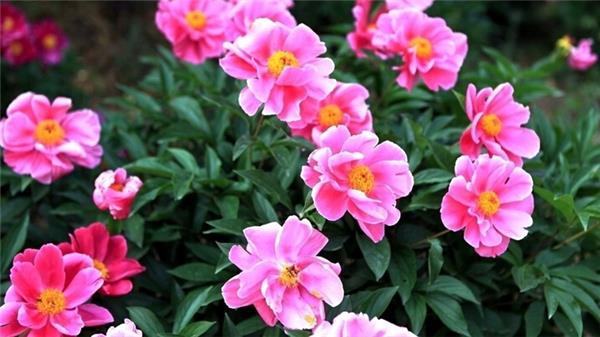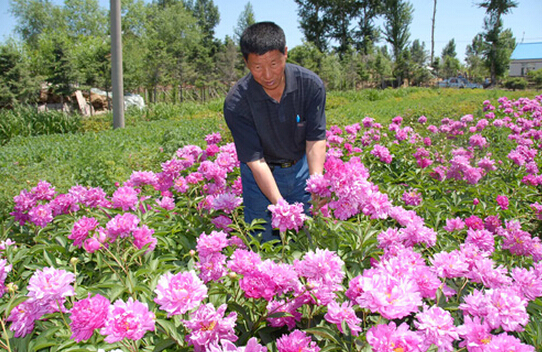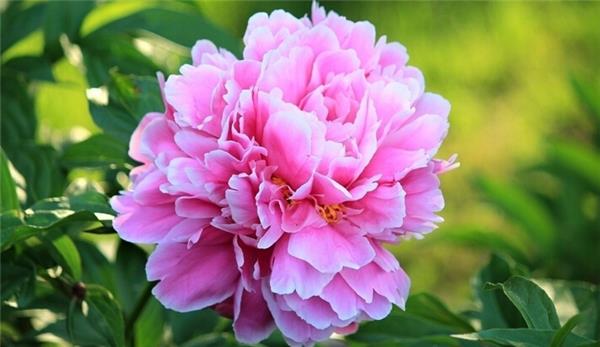How to easily master how to raise peony flowers and what are their effects?
Paeonia lactiflora is cold-resistant, like fertilizer and afraid of waterlogging, like soil moisture, but also resistant to drought, sunshine and cool climate in summer. Potted peony is easy to scorch leaves under the scorching sun in midsummer, so you should pay attention to shading. Paeonia lactiflora is a fleshy root with a long root system, so it should be planted in sandy loam with fertile, loose and well-drained soil and perishable roots in clay and low-lying stagnant water. So, what is the breeding method of peony flower?

Culture methods of Paeonia lactiflora
1. Planting time of Paeonia lactiflora: Paeonia lactiflora likes sunshine and cold tolerance, and it should be cool and afraid of heat when the temperature is high, and it does not grow well at high temperature in summer. Autumn is the best time to plant peony.
2. Soil quality: when planting peony, you should choose sunny land with high topography and good drainage, and do not plant it in low-lying places where it is easy to accumulate water. Paeonia lactiflora is a fleshy root, so we should choose loose, fertile and slightly acidic sandy soil when planting. It is not suitable to grow in alkaline soil. If the soil is too alkaline, it will cause leaf yellowing, even shrinkage and death.
3. Main points of cultivation: when cultivated in open field, manure should be applied to turn the stables deeply, and the beds should be arranged after fining. Generally, the height of the border is 10-15 meters, the width of the border is 70 meters, and the length is not limited. The distance between cultivated plants is 80 cm. During cultivation, dig holes according to the length and size of the root system, pay attention to the root should be extended, should not be too deep, cover the soil with a top bud of 4-5 cm, pour water once after planting, and the choked soil will survive the winter.
4. Fertilizer and water management: peony does not need to be watered frequently except for natural precipitation. Usually only in the most water demand before and after flowering and in case of spring drought before and after appropriate watering, in order to supplement the lack of soil moisture, each watering should not be too much. Topdressing should be controlled, three times a year, and the first time it is quickly drawn out in the new shoots. When the leaves and buds are stretching, they mainly apply quick-acting fertilizer, which is called flower-promoting fertilizer.
5. Shaping and pruning: in order to make peony flowers colorful and robust, shaping and pruning is very important. Peony plastic surgery mainly includes fixing stem, pruning, removing buds, thinning buds, cutting off residual flowers and so on. Paeonia lactiflora can be dried after 2-3 years. For the varieties with strong growth potential and exuberant growth, they can be pruned into independent peony. For the varieties with weak growth potential and small number of branches, the thin and weak branches are generally cut off and the strong branches are retained.

6. prevention and control of diseases and insect pests: the common diseases and insect pests of peony are brown spot, anthrax, scab, root rot, root nodule nematode, longicorn beetle, red spider, beetle, mole cricket and so on. The prevention and control of diseases and insect pests should give priority to early prevention, once diseases and insect pests occur. According to the degree of occurrence, according to the above-mentioned dosage, the interval between spraying should be appropriately shortened and the frequency of drug use should be increased.
Before the peony blossoms, after the lateral buds appear, they can be removed in time to concentrate nutrients and promote the beauty of the top bud flowers. After the flower fades, if you do not plan to sow and reproduce, you should cut off the pedicel at any time so as not to seed and consume nutrients. So, do you know what the classification of peony flowers is?
Taxonomic characteristics of flower types of Paeonia lactiflora
1. Single flower: a flower is made up of a single flower
1.1 1000-layer subclass: petals naturally increase in centripetal type, neatly arranged, similar in shape, and gradually become smaller from outside to inside; stamens are only born around the ovary and decrease until disappear with the increase of petals. The flowers are flat.
① single petal: petals 2-3 whorls, broad, with normally developed stamens and pistils, usually referring to the original type.
② lotus type: petals 4-5 whorls, wide, similar in shape and size, normal stamens or individual stamens petals into broken petals, lanceolate petals or whisker petals scattered in the stamen group; pistil normal.
③ chrysanthemum type: petals more than 6 whorls, gradually smaller from outside to inside, stamens normal, less; pistil normal, the number increased or decreased.
④ rose type: petals are extremely increased, gradually smaller from outside to inside, stamens all disappear; pistils are normal, degenerate smaller or disappear completely.

1.2 subclass: outer valve broad, 2-3 whorls; stamens centrifugally valved, pistil normal, petalized or degenerated. Flower-shaped protuberance or towering (except gold core type).
① Jinrui type: outer petal broad, 2-3 whorls, stamen anthers enlarged, filaments thickened, stamens group bright golden yellow; pistil normal.
② Gui type: the outer valve is broad, 2-3 wheels, and the stamens are completely petaloid, acicular or lanceolate, slightly larger from the outside to the inside, erect in the outer valve; the pistil is normal or petaloid into a tongue-like valve, and the color of the lingual valve or the end of the valve is often the primary color of the stigma.
③ gold ring type: the outer valve is broad, 2-3 whorls, the stamens are mostly petalized, the petals are towering, but there is a circle of normal stamens between the stamen valve and the outer valve; the pistil is normal or petalized.
④ crown type: the outer valve is broad and spreading, 2-3 wheels, close to the inner ring of the outer valve, there are a small number of whisker-shaped valve, needle-shaped valve, lanceolate valve or broken valve, above which is the tongue-shaped valve or lanceolate valve formed by the stamen valve, erect, raised, clustered in the outer valve, with a small amount of stamens in the center, or degenerated into a short state; the pistil is normal or petalized or degenerated.
⑤ Hydrangea: most of the stamens petal into a tongue-shaped valve, like the secondary outer valve, when in full bloom, the whole flower is plump, shaped like Hydrangea, the central stamen is very few or degenerated; the pistil becomes smaller or degenerated.
2. Taige refers to the phenomenon that when a plant blossoms, the flower (or inflorescence) center or the growing point between flowers is redifferentiated into flower buds and blossoms. Another flower (upper flower) is formed in the center of the flower (lower flower), and the upper flower is superimposed with the lower flower, thus increasing the degree of double petal, and some varieties are even made up of 3 or even 4 flowers.

2.1 thousand-layer subclass: the basal single flower (lower flower) has the basic characteristics of the single-flower thousand-layer subclass. Thousand-layer cabinet type (primary cabinet type): the lower flower pistil is normal or slightly petalized; the upper flower is generally normal pistil and stamen. The whole flowers are flattened.
2.2 Laozi subclass: lower petals 2-3 whorls, stamens petalized, pistil petalized or degenerated. All flowers are towering.
① petal cabinet type: lower flower pistil petal, stamen multi-petalized; upper flower pistil and stamen normal or slightly petalized.
② layered cabinet type: the lower flower pistil petal becomes the same as the normal petal, the stamen petal is shorter than the normal petal; the upper flower stamens also turn into short petals, and the pistil petals or degenerate. The whole flower has an obvious hierarchical structure.
③ ball petal cabinet type: the lower flower stamen changes petal elongation and broadens with the normal petal, the pistil change petal also becomes the normal petal; the upper flower stamen change petal is also difficult to distinguish with the normal petal, the pistil petals turn or degenerate. All flowers are globular.
Everyone loves beautiful flowers. In fact, beautiful flowers not only have ornamental value, but also have their own unique functions in other aspects. Traditional Chinese medicine can be made in medicine, which can bring people mood pleasure and visual enjoyment in daily life, and it can also purify the air at home. Below to understand the efficacy and role of Paeonia lactiflora.
The function and efficacy of peony flower: nourish blood and soften liver, dissipate depression and dispel blood stasis, improve facial chloasma, rough skin aging, heat release, nourish blood and soften liver, strengthen five internal organs, disperse evil blood, regulate menstruation. It can treat freckles, chloasma and acne caused by endocrine disorders. Promote metabolism, improve body immunity, inhibit acne on the face, and delay skin aging. Nourish the blood and soften the liver, make the qi and blood abundant, the appearance ruddy. It has the functions of clearing heat and relieving heat, removing spots, clearing heart and moisturizing lungs, calming liver and eyesight, skin care and beauty, etc. Regular drinking can make you full of qi and blood, ruddy appearance and full of spirit. It can regulate female endocrine, remove yellow gas and color spots, and make peony flower face moist.

Paeonia lactiflora still exists in western mythology, saying that in ancient mythology there was a famous Greek doctor named Asclipier, who had an apprentice who was better than blue and even healed the wound of Hethys, the underworld. Asclepier was very jealous and was driven by jealousy to kill his apprentice. Later, because the Keeper took care of the kindness, he turned it into a kind of flower that can cure diseases. Because Paeonia lactiflora is also a powerful medicine in the eyes of Westerners. In Western legends, peony can even fight the poison of Datura flowers. I hope you can learn more about the breeding methods of peony flowers through the introduction of the editor.
2. Taige refers to the phenomenon that when a plant blossoms, the flower (or inflorescence) center or the growing point between flowers is redifferentiated into flower buds and blossoms. Another flower (upper flower) is formed in the center of the flower (lower flower), and the upper flower is superimposed with the lower flower, thus increasing the degree of double petal, and some varieties are even made up of 3 or even 4 flowers.

2.1 thousand-layer subclass: the basal single flower (lower flower) has the basic characteristics of the single-flower thousand-layer subclass. Thousand-layer cabinet type (primary cabinet type): the lower flower pistil is normal or slightly petalized; the upper flower is generally normal pistil and stamen. The whole flowers are flattened.
2.2 Laozi subclass: lower petals 2-3 whorls, stamens petalized, pistil petalized or degenerated. All flowers are towering.
① petal cabinet type: lower flower pistil petal, stamen multi-petalized; upper flower pistil and stamen normal or slightly petalized.
② layered cabinet type: the lower flower pistil petal becomes the same as the normal petal, the stamen petal is shorter than the normal petal; the upper flower stamens also turn into short petals, and the pistil petals or degenerate. The whole flower has an obvious hierarchical structure.
③ ball petal cabinet type: the lower flower stamen changes petal elongation and broadens with the normal petal, the pistil change petal also becomes the normal petal; the upper flower stamen change petal is also difficult to distinguish with the normal petal, the pistil petals turn or degenerate. All flowers are globular.
Everyone loves beautiful flowers. In fact, beautiful flowers not only have ornamental value, but also have their own unique functions in other aspects. Traditional Chinese medicine can be made in medicine, which can bring people mood pleasure and visual enjoyment in daily life, and it can also purify the air at home. Below to understand the efficacy and role of Paeonia lactiflora.
The function and efficacy of peony flower: nourish blood and soften liver, dissipate depression and dispel blood stasis, improve facial chloasma, rough skin aging, heat release, nourish blood and soften liver, strengthen five internal organs, disperse evil blood, regulate menstruation. It can treat freckles, chloasma and acne caused by endocrine disorders. Promote metabolism, improve body immunity, inhibit acne on the face, and delay skin aging. Nourish the blood and soften the liver, make the qi and blood abundant, the appearance ruddy. It has the functions of clearing heat and relieving heat, removing spots, clearing heart and moisturizing lungs, calming liver and eyesight, skin care and beauty, etc. Regular drinking can make you full of qi and blood, ruddy appearance and full of spirit. It can regulate female endocrine, remove yellow gas and color spots, and make peony flower face moist.

Paeonia lactiflora still exists in western mythology, saying that in ancient mythology there was a famous Greek doctor named Asclipier, who had an apprentice who was better than blue and even healed the wound of Hethys, the underworld. Asclepier was very jealous and was driven by jealousy to kill his apprentice. Later, because of the Keeper's concern for kindness, he turned it into a kind of flower that can cure diseases. Because Paeonia lactiflora is also a powerful medicine in the eyes of Westerners. In Western legends, peony can even fight the poison of Datura flowers. I hope you can learn more about the breeding methods of peony flowers through the introduction of the editor.
Related
- Wuhan Hospital Iron Tree Blooming Result Was Instantly Frightened by the Gardener Master
- Which variety of camellia is the most fragrant and best? Which one do you like best?
- What is the small blue coat, the breeding methods and matters needing attention of the succulent plant
- Dormancy time and maintenance management of succulent plants during dormancy
- Minas succulent how to raise, Minas succulent plant pictures
- What are the varieties of winter succulent plants
- How to raise succulent plants in twelve rolls? let's take a look at some experience of breeding twelve rolls.
- Attention should be paid to water control for succulent plants during dormant period (winter and summer)
- Watering experience of twelve rolls of succulent plants
- Techniques for fertilizing succulent plants. An article will let you know how to fertilize succulent plants.



